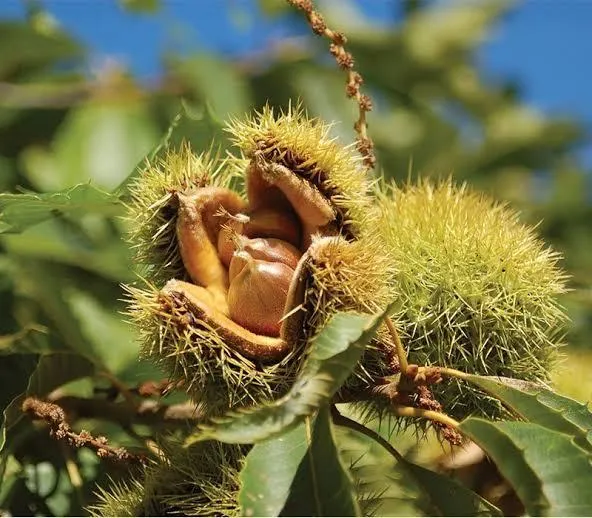
The Chestnut Comeback? EBCI and Hybrid chestnuts
Update (July 1, 2025)
We want to provide a clarification regarding this article. The Eastern Band of Cherokee Indians (EBCI) has not participated in field trials of transgenic (genetically modified) American chestnut trees. No genetically modified chestnut trees have been planted within the Qualla Boundary.
The EBCI’s collaboration with The American Chestnut Foundation focuses on planting hybrid chestnut trees, which are a cross between American chestnuts and Chinese chestnuts. These efforts aim to support the restoration through natural and hybrid approaches that align with Cherokee environmental values.
For more information on the EBCI’s work on chestnut restoration, see this report from The Cherokee One Feather.
We appreciate our readers and the EBCI Natural Resources team for bringing this to our attention.
By Staff | Cherokee 411
The American chestnut tree, once known as the “redwood of the East,” is inching closer to a potential comeback—but not without controversy. This month, the U.S. Department of Agriculture (USDA) reopened its public comment period on the deregulation of a genetically modified (GMO) chestnut tree designed to resist the blight that nearly wiped out the species a century ago. And the Eastern Band of Cherokee Indians (EBCI) is one of the few tribal nations directly involved in testing its future.
The chestnut was more than just a tree—it was a foundational part of Cherokee culture, sustenance, and ecology. Its loss due to blight in the early 1900s marked the end of an era. Today, efforts to revive it are raising complex questions: Can modern science bring it back? And if it does, will it still be truly Native?
Cherokee Roots and Biotech Branches
For over a decade, EBCI has participated in field trials of the transgenic tree known as Darling 58, developed by the SUNY College of Environmental Science and Forestry. The tree contains a gene from wheat that helps it tolerate the blight fungus, but this genetic modification means it falls under federal regulation—and public scrutiny.
The USDA's Animal and Plant Health Inspection Service (APHIS) is now giving the public another opportunity to weigh in. From June 14 to July 15, citizens, scientists, and tribal leaders can submit their views on whether the Darling 58 should be released into wild forests.
Cultural Stewardship vs. Technological Solutions
For Cherokee people, the chestnut was historically a source of food, medicine, and materials. Its return could offer ecological restoration, cultural reconnection, and even economic opportunity. But the use of genetic modification complicates things. Some tribal members question whether this version of the tree still carries the same spirit or relationship to the land.
The EBCI’s Office of Natural Resources, however, has expressed hope that careful use of science can support traditional ecological knowledge and help restore a key species.
Still, Native nations across Turtle Island have not reached a consensus. Some call for stricter regulations and cultural impact assessments before biotech-based restoration is approved. Others see this as a path toward climate resilience and sovereignty over ecological futures.
Why This Matters Now
This decision could set a precedent—not just for chestnuts, but for how genetic technologies intersect with Indigenous stewardship and ecological restoration. If approved, the Darling 58 would be the first genetically modified tree allowed to reproduce freely in U.S. forests.
The Cherokee Nation, United Keetoowah Band, and other tribes have not publicly stated positions on the GMO chestnut. With the USDA reopening the comment period, now is the time for Cherokee voices to speak up—whether in support, opposition, or caution.
Have Your Say
The USDA is accepting public comments through July 15, 2025. You can read the proposal and submit your thoughts at the USDA’s official portal here:
🔗 Link to USDA Comment Page
What do you think? Should modern science bring back the chestnut, even if it’s genetically modified? Would you plant one on your land?
Let us know in the comments, or message Cherokee 411.
We are Cherokee. Our forests have stories to tell. Let’s make sure our voices are part of the next chapter.
